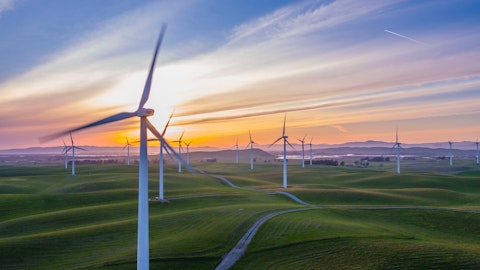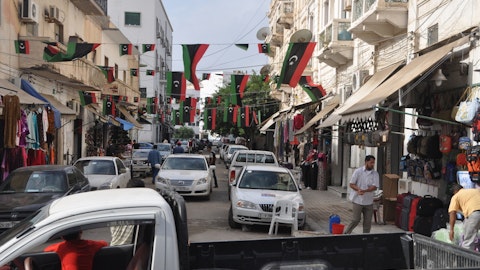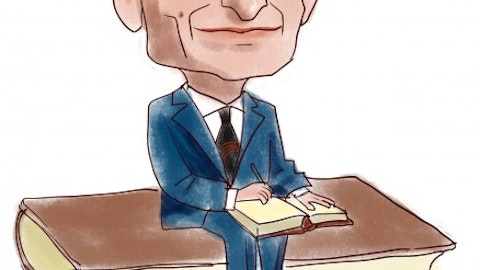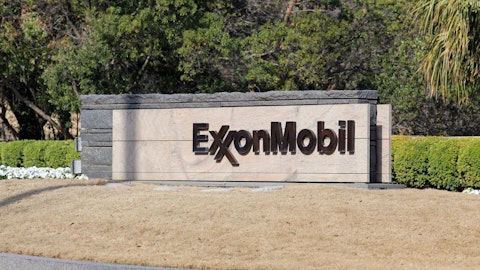Equinor ASA (NYSE:EQNR) Q3 2023 Earnings Call Transcript October 27, 2023
Operator: Thank you for standing by and welcome to the Equinor Q3 2023 Analyst Call. All lines have been placed on mute to prevent any background noise. [Operator Instructions]. Thank you. I’d now like to welcome Bard Glad Pedersen, Senior Vice President of Investor Relations to begin the conference. Bard, over to you.
Bard Glad Pedersen: Thank you, operator, and good morning to everybody on this call. As the operator said, my name is Bard Glad Pedersen, and I’m heading up Investor Relations in Equinor. I’m here together with our CFO, Torgrim Reitan, he will take us through the results before we start the Q&A section and we will try to keep this within one hour in total. So, with that, I give the word to you, Torgrim.

Workers in hard hats and safety gear processing oil and gas in a US refinery.
Torgrim Reitan: So, thank you, Bard. And good morning, everyone, and thank you for joining us. Today, we delivered strong results. In a quarter with lower prices than the extraordinary levels we saw last year. We have strong adjusted earnings of $8 billion and $2.7 billion after tax. Our net operating income came in at $7.5 billion and net income was $2.5 billion. Year-to-date, we have a strong cash flow from operations after tax of $17 billion. This corresponds well to what we said at our Capital Markets Day in February, when we expected to deliver on average $20 billion annually all the way to 2030. We are on track with our delivery this year. European gas prices are significantly lower than last year. Storages are now for all practical purposes full, and this is as expected.
However, the gas market is tight, and it is still very sensitive. We have seen price spikes related to possible strikes in Australia, the terrorist attack on Israel, and the situation with the Baltic pipeline. This winter, prices will again depend on weather, gas demand recovery in Europe, competition for LNG from Asia, and any supply disruptions. We believe volatility will continue into the winter and for the coming years. During the quarter, we have seen strengthening liquids prices, and we captured these higher prices through increased liquids production across our portfolio. Our NCS gas production, however, is down due to planned maintenance but also due to unplanned extended turnarounds. And I will come back to production later in my presentation.
We had strong liquid sales and trading that drove our MMP results above the increased guidance for the quarter. This fall, we have passed significant milestones, and I’m proud of the hard work and collaboration of our colleagues who make this happen. In early October, we saw first power at the Dogger Bank, the world’s largest offshore wind farm. When fully complete, its 3.6-gigawatt capacity with 277 turbines will produce enough energy to power the equivalent of 6 million British homes. This is a large and profitable project with inflation-adjusted offtake contracts that support value creation. So, we see progress, but the offshore wind industry is also experiencing challenges with inflation, higher interest rates, and supply chain bottlenecks.
See also 12 Best Undervalued Energy Stocks To Buy According to Analysts and 15 Easiest Smartphones to Use for Seniors and the Elderly.
Q&A Session
Follow Equinor Asa (NYSE:EQNR)
Follow Equinor Asa (NYSE:EQNR)
Our petition to New York for price adjustment of projects on the U.S. East Coast was denied together with similar petitions from many other developers. Contrary to in the UK and Poland, offtake contracts here or in the U.S. are not inflation-adjusted. So, based on this, we have taken an impairment on the U.S. East Coast projects. We are now assessing the impact of New York’s decision, and we are working closely with the state as they further develop their 10-point action plan to expand and support the renewable industry. Last night, New York advanced an expedited renewable energy procurement process, as they call it, as part of the 10-point plan. We welcome this, but it is important for me to say that our project, they must be financially robust to proceed.
More broadly, we remain confident that offshore wind will be important for the energy transition and that we can be a leader in this industry. Our strategy to profitably grow in renewables remains firm. We have a strong portfolio within offshore wind, but also within onshore renewables where we have accessed attractive opportunities when prices for offshore wind have been too high. For example, our bolt-on acquisitions of BeGreen in Denmark, Wento in Poland, and Rio Energy in Brazil. Energy security remains very important. We have mature projects with high value and low emissions. And just last week, we brought Breidablikk on stream, on cost, and four months ahead of schedule. At plateau, Breidablikk is expected to send 55,000 to 60,000 barrels per day to the market.
This is a subsea tieback to the grand platform in the North Sea, and it is a good example of our use of existing infrastructure generating production with low cost and low emissions. The field is expected to be paid off in less than two years. We also received PDO approval with future projects which will electrify our Hammerfest LNG plant and significantly reduce emissions by 850,000 tonnes per year. And last but not least, in the quarter, we reached our final investment decision and got approval for Rosebank in the UK, a significant project for our international portfolio. We continue with strong capital distribution, in line with what we communicated at our Capital Markets update. For the quarter, the Board approved an ordinary cash dividend of $0.30 per share as well as continuing the extraordinary dividend of $0.60 per share, for a total of $0.90 in cash dividend.
We continue our share buyback program. The fourth and final tranche will be $1.67 billion in line with our program for 2023 of total $6 billion. For this year, we are delivering a total capital distribution of around $17 billion. Then turning to safety. In August, there was a fatality of a crew member who fell overboard on an LNG tanker in Malaysia. The vessel was in operation for Equinor and the tragic incident is affecting everyone involved. So, this is a strong reminder that even with a positive safety trend, we must keep focusing on safety in all our activities. Safety will remain our top priority. In the quarter, we produced 2,007,000 barrels of oil and gas per day. And as you see on the slide, this is essentially more oil, but less gas than in the third quarter last year.
Our liquids production increased 12% compared to this quarter last year, driven by Johan Sverdrup in Norway, we need increased production capacity. Peregrino in Brazil, the partner-operated Vito field in the U.S. Gulf of Mexico, and the addition of Buzzard in the UK. Our NCS gas production, however, is down 16% this quarter, driven by planned maintenance, but also unplanned extended turnarounds on Troll A and the Nyhamna gas processing platform. They’re all back in normal production now, but the impact for the quarter was around 60,000 barrels per day. And we had a similar impact last quarter of around 70,000 barrels per day. Therefore, we have adjusted our guidance for production growth from around 3% to around 1.5% in 2023. Power production for the quarter ended at 883 gigawatt hours.
373 gigawatts of this is from our renewable assets, slightly higher than last year. Driven by onshore renewables in Poland and Hywind Tampen being fully operational. Gas to power production was 510 gigawatt hours from a Triton Power plant, which is lower than in second quarter. So, let’s now turn to our financial results. The prices for both oil and gas are lower than last year. Our realized gas price is down around 75%, 75%, and even more in the U.S. actually. Adjusted earnings in E&P Norway totaled $6.1 billion before tax, driven primarily by strong liquids production. Our E&P International delivered $809 million and our U.S. business posted adjusted earnings of $343 million. Both segments driven by higher liquid production and high realized liquids prices.
Adjusted earnings after tax from our combined international segments was more than $900 million. In our Marketing and Midstream segment, our adjusted earnings came in above our increased guidance with $876 million. This was driven by strong liquid sales and trading due to our ability to capture opportunities in inefficient markets and our strong performance from our LNG and shipping activities. Our renewables business post negative results as we continue to invest in new projects and business developments. We see operating costs coming down with 2% from second quarter, from last quarter. But costs have increased over several quarters, so we will continue with strong cost management and capital discipline. We had net impairments in the quarter of $971 million.
This includes impairments for a field in the North Sea and the Mongstad refinery, and the reversal for a field in the Gulf of Mexico. The impairment of our U.S. East Coast offshore wind project is $300 million. Here, we now have a remaining book value totaling around $300 million, $100 million in the projects, and around $200 million related to real estate in New York and cables. Our total exposure also includes additional commitments related to infrastructure hand contracts with suppliers. But you should also remember, we entered these U.S., excuse me, these U.S. East Coast projects early, and we paid less than $200 million on a 100% basis. Related divested 50% and we booked a gain of $1 billion. In the quarter, cash flow from operations was $11.3 billion and $7.6 billion after tax.
We have paid one tax installment of around $3.7 billion and capital distribution of $3.1 billion. Next quarter, we are paying two NCS tax installments of around $3.75 billion each and one additional tax payment of $1 billion due to increased commodity prices. After tax, capital distribution, and capital expenditures, our net cash flow was positive $1.5 billion. For the full year, we expect to have negative net cash flow as discussed at CMU. And with higher tax payments next quarter, we expect negative net cash flow in the fourth quarter. So far, we have negative $5 billion for the year and this is in line with our expectation. We have a robust financial position with cash, cash equivalents, and financial investments of $40.2 billion. And a net debt-to-capital employed ratio of negative 22.9%.




